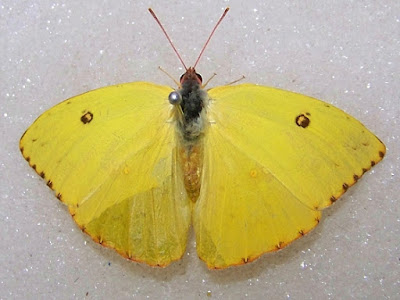Hiking
a trail at Valley Water Mill Park I came across a small redbud tree
with two branches covered with the cases above, over 200 total. They
were fastened on dead and green leaves as well as on the stems. Most
had a hole where a previous occupant had exited but some were still
intact. It was obvious that what ever these had been they were quite
gregarious.

 |
| Campoplegine - silk cocoon underneath |
I sent photographs to Dr. Scott Shaw. He has written extensively on parasitoid wasps
and he quickly responded that it looked like a "campoplegine
ichneumonid. That would be the case if you can see the parasitoid silk
cocoon underneath. Rogadine braconids cause a complete mummy of the
caterpillar (no silk cocoon visible)." A side view confirmed that
suspicion.
Identifying a host caterpillar was a vexing
problem. After several dead ends I searched for "gregarious
caterpillars redbud" and eventually came up with four suspects,
Redhumped caterpillar-
Schizura concinna, White Flannel Moth-
Norape ovina, Io moth-
Automeris io and Yellownecked caterpillars-Datana ministra. I started from the top and found this Redhumped caterpillar
Bugguide link, a photograph with parasitized specimens identical to mine.

Redhumped
caterpillars (RH) are colorful and actually pretty, that is if they
aren't skeletonizing your redbud leaves in mass. They feast on a wide
variety of woody plants and when they gang up on a leaf they are easy
pickings for a parasitoid wasp depositing one egg per customer. They
will become a rather nondescript moth which has the cute habit of
resting with its butt up in the air.
I was comparing the color and size of the RH cats and
realized that these were parasitized at an early age. The leaves
hadn't been severely damaged and they were probably in the first instar
when the wasp found them. The literature suggests that a wasp can lay
100 eggs so this must have been a super fertile female or had a friend.
Searching for parasitoids on Redhumps I came across this
UC IPM publication listing two parasitic wasps attacking them,
Hyposoter fugitivus, and
Cotesia Schizurae. This photograph of
H. fugitivus from UC-IPM looks like a perfect fit. I am waiting for confirmation.

I
took several leaves home for study and after photographing them under
the microscope I stored those without holes in separate containers. Two
days later we announced the arrival of a bouncing baby wasp. I watched
it crawl around in its clear plastic box until I had to freeze it to
photograph without it flying away. Considering that over a hundred of
its siblings had already emerged, I don't think this disrupted the cycle
of nature.
Life began for these wasps when their mother laid an
egg in each of the small caterpillars. As the larva emerges and starts
to eat, the caterpillar continues to grow. By the third or fourth
instar it dies as the larva emerges and spins a cocoon to form a pupa.
This includes the flattened silk attachment to the leaf, tight enough
that when I was pealing it away from the cocoon case it frequently
brought some leaf with it.
When the male emerges, it
will likely hang around to mate with emerging females, a steamy meeting
described in this 1967 paper with the unromantic title of
Sexual Behavior In Hyposoter fugitivus Hymenoptera Ichneumonidae.
The male touched the female's antennae, wiggling his alternating
sides. Then he started "vigorous wing fluttering" and.....we you know
the rest and this
is a family blog.
A pair of these
H. fugitivus and
a few representative cocoon cases are in the mail, sealed in alcohol on
their way for conformation and will become voucher specimens in the University of Wyoming
Insect Museum, a long trip for a little wasp.
Special thanks to Dr. Scott Shaw for patiently sharing his knowledge this last week. He is Professor of Entomology at the University of Wyoming,
Insect Museum Curator and the author of Planet of the Bugs.
You will be interested to know that the presumed primary parasitoid,
Hyposoter fugitivus (which caused the mummy), is known to have at least 12 different hyperparasitoids. With a bit more research I was able to determine with high confidence that the 3 wasps you sent are
Isodromas lycaenae(Howard), a cryptine ichneumonid known to hyperparasitize
Hyposoter. This is the wasp in your photos. Nice catch.
This could be quite an interesting project for you and your students, if you can find more of the mummies. With some patience, and by collecting many samples, you might rear 13 different wasps from the same caterpillar mummy! You might be more likely to get the primary parasitoid,
Hyposoter fugitivus, if you find solitary mummies. The ones in groups, like you found, are far more likely to get hit by hypers.



















































